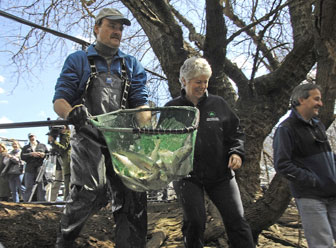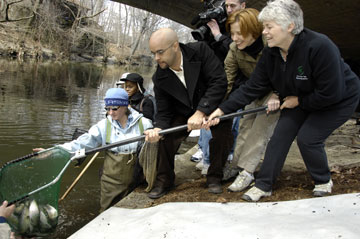Herring fish restored to Bronx River in New York City
Herring fish restored to Bronx River in New York City
WCS release
April 6, 2007
Building on last year’s first-ever successful stocking of river herring in the Bronx River, an estimated 400 additional fish were released today in an ongoing effort to establish a breeding population of these native fish in one of the nation’s most urbanized waterways. The release, which took place on the grounds of the Bronx Zoo, is part of a partnership among a diverse group of officials, biologists and citizen’s groups to restore the Bronx River, the only remaining fresh water river within New York City’s borders.
Congressman José E. Serrano secured funding to study and implement a river herring restoration project on the Bronx River through a federal partnership grant to the Wildlife Conservation Society (WCS), the Bronx Zoo’s parent organization, from NOAA National Marine Fisheries Service. WCS in turn funded the New York City Department of Parks and Recreation’s Natural Resource Group and Lehman College to implement and monitor the project. The Connecticut Department of Environmental Protection (CTDEP) Inland Fisheries Division donated the fish, truck, and labor to trap and transport the fish for stocking.
 Steve Gebhardt of the Connecticut Department of Environmental Protection (CTDEP) Inland Fisheries Division and Linda Cox, Executive Director of the Bronx River Alliance bring the first net-full of the estimated 400 alewife (river herring) which were release today into the Bronx River on the grounds of the Bronx Zoo, headquarters for the Wildlife Conservation Society. The release was part of an ongoing effort to restore the herring to a former habitat and to bring back the Bronx River to ecological health. Photo by Julie Larsen Maher / WCS. |
“I’m so happy that the program to reintroduce herring into the Bronx River is continuing with its work to bring these fish back to their native waters,” Congressman Serrano said. “Today’s release, combined with the beaver’s return to the river earlier this spring after a 200 year absence, shows that our efforts to clean and restore this river are truly paying off. The river is rapidly becoming a place where wildlife can thrive. It’s a transformation of historic proportions, and I salute all those who have worked to make it a reality. I’m glad that I have been able to secure funding for this vital project and look forward to more Bronx River successes in the near future.”
In 2001, NOAA began awarding grants to WCS, the NYC Parks & Recreation’s Natural Resources Group, and other community organizations, as a means to help restore estuarine salt marsh and freshwater river in-stream, bank, and floodplain habitats in the lower Bronx River. The focus of the partnership which NOAA developed has been: “Connecting the Community with the Lower Bronx River,” and has allowed grant funds to be awarded to a number of local non-governmental organizations (NGOs). One such grant to the Parks Natural Resources Group and Lehman College established the ecological feasibility of introducing fish to the Bronx River.
“With a substantial portion of the Bronx River flowing through our property, we were especially proud to learn that the 200 herring stocked last year took to their new home and successfully spawned — a testimony to the river’s improving health,” said John Calvelli, senior vice president for Public Affairs of WCS, “And just downstream from where we are stocking the herring today is a beaver lodge — home to José the beaver — the first one spotted in New York City in at least two centuries.”
The beaver, nicknamed for Congressman José Serrano, was first suspected to have been seen during the intense observations by Parks Natural Resources Group, Lehman College and WCS of juvenile river herring feeding behavior in the late summer. Follow up investigations by WCS revealed the sightings were correct and the beaver had built a lodge on the zoo’s property.
 An estimated 400 alewife (river herring) were release today into the Bronx River on the grounds of the Bronx Zoo, headquarters for the Wildlife Conservation Society. Pictured here are (left to right) Siddhartha Sanchez, Community Liaison for Immigration and Environmental Affairs at Congressman Jose E. Serrano’s office; Jan Kaderly, WCS Director of Public Affairs; and Linda Cox, Executive Director of the Bronx River Alliance. The release was part of an ongoing effort to restore the herring to a former habitat and to bring back the Bronx River to ecological health. Photo by Julie Larsen Maher / WCS. |
The river herring, known as an “alewife” is one of two types native to New York City waterways. The species is believed to have vanished from the Bronx River as early as the 1600s when dams blocked access to spawning grounds. Like salmon, river herring spawn in freshwater, where the eggs hatch and juvenile fish spend their first few months before swimming downstream to sea. They mature in the open ocean and return as adults to the same stream where they were born to spawn. Alewives are an important source of food for gamefish such as striped bass, bluefish, heron, ospreys, seals, otters, and other mammals in the ocean as well as the estuaries and freshwater sections of the river.
“Parks & Recreation’s Natural Resources Group has played a key role in helping to restore river herring in our region by assessing environmental conditions in the Bronx River and planning a network of fish ladders to facilitate upstream passage,” said Parks & Recreation Commissioner Adrian Benepe. “This project represents the return of a historic species to the Bronx River and is a real testament to the work of Parks and its collaborators in improving water quality and environmental health in the past several decades.”
“We’re delighted to see all of the hard work of the Bronx River Alliance, the City Parks Department, and our many partners pay off with a river that is healthy enough to sustain these fish — and a beaver, too,” said Linda Cox, Executive Director of the Bronx River Alliance and Bronx River Administrator for the New York City Department of Parks & Recreation. “When we saw thousands of young herring flourishing in the Bronx River last year, we had our proof that the river is coming back. This year’s release will build the numbers and add to the ecological value of the river.”
Biologists from Lehman College and New York City Department of Parks and Recreation’s Natural Resource Group will monitor the river herring over the coming weeks to determine whether they have successfully spawned in the river. It is expected that juvenile alewives will migrate to Long Island Sound and other coastal waters, and return to the Bronx River as adults in three-to-five years. Last year, juvenile herring were observed in the river along the Bronx Zoo, and presumably migrated to sea. This first generation of Bronx River alewife is expected to return to the Bronx to spawn in 2009.
In conjunction with alewife stocking, NYC Parks & Recreation’s Natural Resources Group is working with the Wildlife Conservation Society and New York Botanical Garden to develop fish passageways over the dams on the Bronx River in the Bronx. These passageways will allow alewife to swim back up to their spawning grounds over the 182nd Street dam and is expected to be complete by 2009 — just in time for the first returning fish.
The groups feel that establishing a run of herring in such an urbanized waterway will increase recreational opportunities such as fishing, as well as give the community a feeling of stewardship toward the long-neglected Bronx River.
The fish released today came from Bride’s Brook in Connecticut and were transported by truck by Connecticut DEP’s Inland Fisheries Division. The partnership between New York City and Connecticut that has made this stocking possible underscores the regionally significant status of the alewife. This once ubiquitous spring-time occupant of the rivers and tributaries of Long Island Sound and the New York /New Jersey Harbor faces hazards at all stages of its life including: degraded water quality and loss of habitat and access to habitat in coastal and inland streams; disease; predators in freshwater, estuary and open ocean; and commercial fishing. The efforts made on the Bronx River to expand alewife habitat contribute to a region-wide effort to increase the population and extent of this culturally and ecologically important animal.
This is a modified news release from WCS